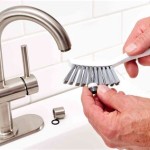How to Remove Grout From Bathroom Floor
Removing grout from a bathroom floor is a common task undertaken during renovations, repairs, or even simple aesthetic updates. Over time, grout can become stained, cracked, or crumbled, detracting from the overall appearance and potentially leading to water damage. While the process requires patience and the right tools, it is manageable for most homeowners, allowing for a fresh, clean look for the bathroom floor.
This article provides a comprehensive guide to removing grout from a bathroom floor, covering essential tools, preparation steps, and various removal methods. Understanding the different types of grout and the appropriate techniques for each will ensure a successful and damage-free result. Prioritizing safety and taking the necessary precautions are also crucial aspects of this process.
Understanding Grout Types and Their Properties
Before commencing grout removal, it is important to identify the type of grout present on the bathroom floor. Different grout compositions require different approaches for effective removal. The two most common types of grout are cement-based grout and epoxy grout. Cement-based grout is further categorized into sanded and unsanded varieties.
Sanded grout contains fine sand particles to provide strength and prevent cracking in wider grout lines, typically exceeding 1/8 inch. It is commonly used for floor tiles and areas subject to heavy foot traffic. Unsanded grout, conversely, lacks sand and is used for narrower grout lines, often found on walls or delicate tile materials that are susceptible to scratching.
Epoxy grout is a two-part system consisting of epoxy resin and a hardener. It is known for its superior durability, stain resistance, and waterproof properties, making it ideal for frequently wet environments like bathrooms. Epoxy grout is significantly more challenging to remove than cement-based grout due to its chemical bonding characteristics.
Determining the grout type can often be achieved through visual inspection. Sanded grout will have a slightly rough texture due to the sand particles, while unsanded grout will be smoother. Epoxy grout typically has a glossy finish and is highly resistant to staining. If uncertain, consulting the original tile installation documentation or testing a small, inconspicuous area with different removal methods can help identify the grout type.
Essential Tools and Safety Precautions
Having the right tools will significantly impact the efficiency and effectiveness of grout removal. Furthermore, prioritizing safety during the removal process is paramount to prevent injury and damage to the surrounding area.
Essential tools for grout removal include:
*Grout Removal Tool:
This can be a manual grout saw, an oscillating multi-tool with a grout removal attachment, or a power grout removal tool. The choice depends on the size of the area and the user's comfort level. *Utility Knife:
Useful for scoring and loosening grout edges. *Hammer and Chisel (Optional):
For particularly stubborn grout or small areas. It's crucial to use care to avoid damaging the tiles. *Shop Vacuum:
Essential for removing grout dust and debris. *Scraper:
For removing softened grout. *Spray Bottle:
For applying grout softener or water. *Protective Eyewear:
Prevents grout dust and debris from entering the eyes. *Dust Mask or Respirator:
Protects the respiratory system from harmful grout dust. *Gloves:
Protects hands from irritation and sharp tools. *Knee Pads:
Provides comfort during extended periods of kneeling. *Drop Cloths or Plastic Sheeting:
Protects surrounding surfaces from dust and debris.Before beginning, ensure proper ventilation by opening windows or using a fan. Wear protective eyewear, a dust mask, and gloves throughout the entire process. Cover nearby surfaces with drop cloths to prevent dust from settling. When using power tools, adhere to the manufacturer's instructions and safety guidelines.
Step-by-Step Grout Removal Methods
The specific method for removing grout depends on the type of grout and the tools available. Here are several common techniques, each with its own advantages and disadvantages:
1. Manual Grout Removal (Grout Saw):
This method is suitable for smaller areas and is less likely to damage surrounding tiles. A manual grout saw is a hand-held tool with a carbide-tipped blade designed to grind away grout.
*Preparation:
Clean the grout lines with a brush and vacuum to remove loose debris. *Scoring:
Use a utility knife to score along the edges of the grout lines to create a clean break. *Sawing:
Hold the grout saw at a 45-degree angle and use a back-and-forth motion to grind away the grout. Apply consistent pressure, being careful not to damage the tile edges. *Removal:
Work in small sections, removing grout in layers. Vacuum frequently to remove dust and debris. *Finishing:
Use a scraper or utility knife to remove any remaining grout residue.2. Oscillating Multi-Tool with Grout Removal Attachment:
An oscillating multi-tool equipped with a grout removal attachment is a faster and more efficient option for larger areas. The oscillating motion breaks down the grout without excessive force.
*Preparation:
Clean the grout lines with a brush and vacuum. *Attachment:
Secure the grout removal attachment to the multi-tool. *Removal:
Position the tool at a low angle and guide it along the grout line, allowing the oscillating motion to break down the grout. Start with a low speed and gradually increase as needed. *Vacuuming:
Vacuum frequently to remove dust and debris. *Caution:
Be careful not to apply too much pressure, which can damage the tiles. Keep the tool moving to prevent overheating.3. Power Grout Removal Tool:
Power grout removal tools are specifically designed for removing grout quickly and efficiently. These tools typically have a rotating head with specialized blades or brushes.
*Preparation:
Clean the grout lines. *Tool Setup:
Follow the manufacturer's instructions for setting up the tool and selecting the appropriate attachment. *Removal:
Guide the tool along the grout line, allowing the rotating head to remove the grout. Use light pressure and maintain a steady pace. *Safety:
Wear appropriate safety gear and follow the manufacturer's safety guidelines. Be mindful of dust and flying debris.4. Chemical Grout Softeners:
Chemical grout softeners can help loosen grout, making it easier to remove with other methods. These products are typically applied to the grout lines and allowed to soak for a specified period.
*Application:
Apply the grout softener according to the manufacturer's instructions. Ensure adequate ventilation. *Soaking:
Allow the softener to soak for the recommended time, typically 15-30 minutes. *Scraping:
Use a scraper to remove the softened grout. *Rinsing:
Rinse the area thoroughly with water to remove any remaining softener. *Caution:
Use caution when working with chemicals. Wear gloves and eye protection. Avoid prolonged exposure to fumes.5. Heat Gun Method:
For epoxy grout, heat guns can be useful. The heat softens the epoxy making it easier to scrape away. Be very careful with this method and use it as a last resort.
*Preparation:
Wear heat-resistant gloves and eye protection. Ensure adequate ventilation. *Heating:
Carefully apply heat to a small section of the epoxy grout for a short period. Avoid overheating the tiles. *Scraping:
Immediately use a scraper to remove the softened grout. *Caution:
This method can be dangerous if not used properly. Overheating can damage tiles or cause burns. Work in small sections and monitor the temperature closely.Addressing Specific Challenges
Certain situations may present unique challenges during grout removal. These include working with delicate tiles, removing grout from tight corners, and dealing with heavily stained or damaged grout.
Delicate Tiles:
When working with delicate tiles, such as glass or natural stone, extra caution is required to prevent scratching or chipping. Use manual grout removal methods and avoid power tools. Apply gentle pressure and work slowly and deliberately. Protect the tile surfaces with masking tape to prevent accidental damage.Tight Corners:
Removing grout from tight corners can be challenging with larger tools. Use a utility knife or a small grout saw to carefully remove the grout. A small chisel can also be helpful, but use it with extreme caution to avoid damaging the tiles.Heavily Stained or Damaged Grout:
Heavily stained or damaged grout may require more aggressive removal methods. Consider using a combination of chemical grout softeners and mechanical removal techniques. For particularly stubborn stains, a grout stain remover can be used after the grout has been removed.Cleaning and Preparing for New Grout
After removing the old grout, it is essential to thoroughly clean the area and prepare it for the new grout. This will ensure proper adhesion and prevent future problems.
*Vacuuming:
Vacuum the grout lines thoroughly to remove any remaining dust and debris. *Cleaning:
Clean the area with a mild detergent and water. Use a scrub brush to remove any stubborn residue. *Rinsing:
Rinse the area thoroughly with clean water. *Drying:
Allow the area to dry completely before applying new grout. This may take several hours or even overnight. *Inspection:
Inspect the area for any cracks or damage to the tiles. Repair any damaged tiles before applying new grout.By carefully following these steps, homeowners can successfully remove grout from their bathroom floor and prepare the area for a fresh, new look. Remember to prioritize safety and take the necessary precautions to prevent injury and damage. With patience and the right tools, this task can be accomplished effectively and efficiently.

How To Clean Grout Tile Cleaning Tips Simply Spotless

How To Remove Old Grout

7 Most Powerful Ways To Clean Tiles Grout Naturally

How To Clean Grout Cleaning Stains

How To Remove Grout From Tile A Complete Diy Guide

How To Clean Grout Between Floor Tiles Easy Stain Removal

The Ultimate Guide To Cleaning Grout 10 Diy Tile Cleaners Tested Bren Did

How To Clean Grout Dirty In Five Minutes Without Using Bleach Express Co

How To Regrout Tiles Without Removing Old Grout

Removing Dried On Grout And Refreshing Lines House Cleaning Tips Spring S
Related Posts







